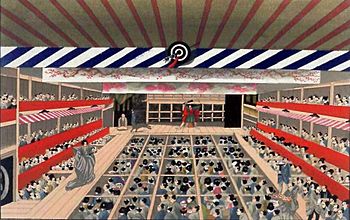 |
| Kabuki Theater (Photo credit: Wikipedia) |
This work has been tampered with over a period of time. The kabuki which we witness now isn’t the same what it used to be before. The founder of this art was Okuni, who was a young lady who served a Shinto shrine named Izumo Taisha. She gained attention by adapting a completely new dance form at the theaters at the dry river beds of Kyoto in the year 1603. Basically, it started with an only female artist who even did the role of men. The stories were based on the common people with a comedic twist. After the initial success, Okuni was invited to show her performance at the royal court. Out of envy, other troupes began adopting the same style of dancing and kabuki became a common style. The women involved in kabuki began entering prostitution so they were banned from performing further and men took over their place. The attention shifted from dance to performance. But the performance by the men also became salacious and they too started prostitution as a side profession and worked for both men and women customers. This affected the audiences which attended this performance they became ill-mannered and a fight used to break out over a young and handsome actor. This led to the imposing of a ban on young male actors too.
Kabuki then became a field of art for matured men. These men put in more effort to bring up the reputation of kabuki. The men who performed the role of women were known as Oyama or Onnagata. Basically, there were two types of a role named Aragoto or rough style and Wagoto or Sakata tojuro. Yaro kabuki or men’s kabuki was the stylized version and Kyogen comic theater was a very influential factor as it was very popular then.
The kabuki artists wore detailed makeup. Aragoto character or the reckless warrior character has a pompous role with bright clothing and loud makeup. The style too is loud and exaggerated and involves more action. On the contrary, Wagoto is a more cultured role with decent dialogue delivery and gestures.
The Genroku period showed more interest in Kabuki arts. It had started to be performed in formal theaters. Chikamatsu Monzaemon was the first known playwright of kabuki and later on produced many other renowned works. His works revolve around tragic-romances where the lovers used to suicide in the end. Many followed this theme which forced the authorities to put a ban on such kinds of plays known as Shinju Mono. After few years of success, kabuki was taken over by Bunraku or Puppetry. This was due to the increase in the number of Bunraku playwrights.
But after the defeat of Tokugawa Shogunate Empire in 1868 kabuki arts returned to its full form. Initially, a kabuki performance was made in front of the king Meiji. It caught his interest in the first instance. Many kabuki theaters were brought up during that era.
During the World War II, many theaters were lost during the bombing and a ban was levied on kabuki. But in 1947, the kabuki performances started again with the lift of the ban and once again began to flourish across the country.
